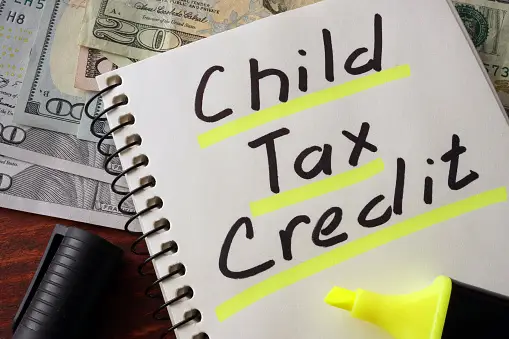- August 17, 2023
- Posted by: Marc Laguerrier
- Category: Blog

Understanding the intricate web of tax legislation can be daunting, especially when it comes to benefits specifically tailored for families like the Child Tax Credit. The year 2023 brings some crucial changes that every parent and guardian needs to comprehend fully. Navigating these modifications without assistance is like venturing into a thick forest without a map. But worry no more! We’re here to outfit you with the knowledge you need to conquer this daunting task. In this comprehensive guide, you will find every ounce of information you need about the Child Tax Credit of 2023 – essential updates, eligibility requirements, calculation methods, claim procedures, and much more. Follow us down this path as we unravel all there is to know about the 2023 Child Tax Credit. Gear up as we anticipate your queries and unlock the potential for maximum savings in your 2023 tax return!
Our Ultimate Guide to Child Tax Credit covers the basics of the credit, including eligibility requirements, how to claim it, and how it differs from other tax credits. Additionally, this guide provides tips for maximizing your credit and outlines recent changes made to the credit. You’ll be equipped with the knowledge needed to take full advantage of this important benefit for families.
Overview of the Child Tax Credit
The Child Tax Credit is an essential federal tax benefit that provides financial support to eligible American taxpayers who have children. It aims to alleviate the financial burden of raising dependent children and provide some relief for families. This credit allows taxpayers to reduce their federal income tax liability by a certain amount for each qualifying child they have.
For the year 2023, the Child Tax Credit is worth up to $2,000 per qualifying dependent child. It is important to note that this credit has both nonrefundable and refundable components. The nonrefundable portion means that if the taxpayer’s tax liability is less than $2,000, they can use this credit to offset their tax bill but will not receive any extra money beyond that. However, up to $1,600 of the credit is potentially refundable, which means if there is still some unused portion after reducing the tax liability to zero, taxpayers may be eligible for a refund of up to that amount.
The IRS releases refunds for returns claiming the Child Tax Credit in mid-February. It is important to file your taxes accurately and on time to ensure prompt processing of your refund. Choosing direct deposit and e-filing usually result in quicker refunds compared to traditional paper filing.
It’s crucial to understand that errors or discrepancies on your tax form regarding the Child Tax Credit can lead to delays or even denials of the credit. Therefore, ensure you carefully fill out all necessary forms and provide accurate information regarding your qualifying child.
For instance, let’s consider a scenario where a single parent with one qualifying dependent child claims the full $2,000 Child Tax Credit. If their tax liability is $1,500, this credit will offset their entire tax bill. However, since the non refundable portion amounts to $400 (total credit – tax liability), only $400 would be considered as a refundable credit.
Now that we have a good grasp of the overview and value of the Child Tax Credit, let’s explore the eligibility criteria required to claim this tax benefit.
Eligibility Criteria for Claiming
To qualify for the Child Tax Credit, you need to meet certain eligibility requirements. These criteria ensure that the credit is targeted towards those who genuinely need it most.
Age: The child being claimed for the credit must be under the age of 17 at the end of the tax year.
Relationship: The child must be your son, daughter, stepchild, foster child, brother, sister, stepbrother, stepsister, half-brother, or half-sister.
Dependent Status: The child must be a qualifying dependent and meet specific requirements regarding support and residency. They generally must live with you for more than half of the tax year.
Residency: Both you and your child must have a valid social security number, and you must be a U.S. citizen, national, or resident alien. Moreover, your child needs to have lived with you in the United States for at least half of the year.
Financial Support: You must provide more than half of the financial support for your child throughout the tax year.
Income Requirements: The income thresholds determine eligibility for the full amount of Child Tax Credit. For 2023, if your modified adjusted gross income (MAGI) is $400,000 or below (if married filing jointly) or $200,000 or below (for all other filers), you may be eligible for the maximum credit amount. However, as income exceeds these thresholds, the credit gradually phases out until it is no longer available.
It’s important to note that modifications can occur to these eligibility criteria over time due to changes in tax laws and regulations. Therefore, always consult official IRS guidelines and publications to ensure you have accurate and up-to-date information.
Claiming Process for the Child Tax Credit

Claiming the Child Tax Credit (CTC) is a vital step for parents or guardians looking to receive financial assistance. The process involves several criteria and forms that need to be completed accurately to ensure eligibility and a smooth filing experience.
The first step in claiming the CTC is to determine if you meet the eligibility requirements. This includes factors such as the child’s age, relationship to the taxpayer, level of support provided, U.S. citizenship or residency, and income level. It’s crucial to review these requirements carefully and ensure you meet each criterion before moving forward.
Next, you’ll need to gather all the necessary information and documentation to complete the appropriate forms. The main forms used for claiming the CTC are Form 1040 or Form 1040NR, depending on your tax status. These forms will require you to provide personal information, such as your name, social security number, and filing status. You’ll also need to provide information about your child or dependent, including their name, social security number, and relationship to you.
Let’s say you are a single parent with two children under the age of 17. You work part-time and have an annual income that falls within the income limits set for claiming the CTC. To claim the credit, you would need to gather all the necessary information about yourself and your children, including their birth certificates or other proof of age and any relevant custody documentation.
Once you have all the required information, you can proceed with completing either Form 1040 or Form 1040NR. These forms will have specific sections dedicated to claiming the CTC. Make sure to follow the instructions provided by the IRS carefully and accurately fill out each section related to the CTC.
After completing the required forms, it’s essential to review them thoroughly before submitting them to avoid any errors or omissions that could delay your claim or result in an inaccurate credit amount. You may also consider using tax software or consulting a tax professional to ensure accurate completion of the forms and maximize your eligible credit amount.
Finally, once you have completed the necessary forms and reviewed them for accuracy, you can submit your claim for the Child Tax Credit. This can be done electronically if you are e-filing your taxes or by mailing the forms to the appropriate IRS address if you are filing a paper return.
Now that we have covered the claiming process for the Child Tax Credit, let’s dive into understanding Form 1040 and Form 1040NR in more detail.
Form 1040 and 1040NR Explained
Form 1040 and Form 1040NR are two key documents used in the U.S. tax system to report income and claim various tax credits, including the Child Tax Credit (CTC). Understanding these forms is crucial for accurately reporting your income and claiming eligible credits.
Form 1040 is the standard individual income tax return form used by U.S. taxpayers. It covers a wide range of income sources, deductions, and credits. To claim the CTC on Form 1040, you will need to provide information about yourself, your dependents, and any other relevant details required for calculating your eligibility.
Let’s say you are a married couple filing jointly with three children under the age of 17. To report your income and claim the CTC, you would use Form 1040. This form will require you to provide information such as your income from various sources, deductions if applicable, and any other relevant details needed to calculate your taxable income.
On the other hand, if you are a non-resident alien who doesn’t qualify as a U.S. citizen or resident for tax purposes, you may need to use Form 1040NR. This form is specifically designed for non-resident aliens to report their U.S. income and claim any eligible tax credits. If you fall into this category, it’s crucial to understand the specific instructions and requirements provided by the IRS for completing Form 1040NR accurately.
Both Form 1040 and Form 1040NR have specific sections dedicated to claiming the Child Tax Credit. These sections will require you to provide information about your qualifying children or dependents, including their names, social security numbers, and relationship to you.
Having a clear understanding of these forms is essential to ensure accurate reporting and eligibility for the Child Tax Credit. Now that we’ve explored the claiming process and the forms involved, let’s move on to understanding the impact of the American Rescue Plan on the Child Tax Credit.
- Form 1040 and Form 1040NR are two critical forms used in U.S. tax reporting. To claim the Child Tax Credit (CTC), it’s necessary to understand these forms, their requirements for accurate filing, and the information needed to qualify. Both forms have specific sections dedicated to claiming the CTC, requiring details about qualifying children or dependents. Non-resident aliens who don’t qualify as U.S. citizens or residents must use Form 1040NR to report their U.S. income and claim any eligible tax credits. It’s essential to understand the specific instructions and requirements provided by the IRS for completing these forms accurately, ensuring eligibility for the CTC.
The Impact of American Rescue Plan on Child Tax Credit
 The American Rescue Plan, enacted on March 11, 2021, brought substantial changes to the Child Tax Credit, aiming to alleviate financial burdens on families and provide much-needed support for children. These changes have had a significant impact on the Child Tax Credit landscape.
The American Rescue Plan, enacted on March 11, 2021, brought substantial changes to the Child Tax Credit, aiming to alleviate financial burdens on families and provide much-needed support for children. These changes have had a significant impact on the Child Tax Credit landscape.
First and foremost, the Child Tax Credit amount has increased under the American Rescue Plan. Previously set at $2,000 per child, it has now been raised to $3,000 per child for children aged 6-17 and to $3,600 per child for children under the age of six. This expansion means that eligible families can receive a more substantial credit amount, helping them with their financial responsibilities related to raising children.
Not only has the tax credit amount increased, but the eligibility criteria have also been expanded. All working families will now receive the full credit if they make up to $150,000 as a couple or $112,500 as a single parent (Head of Household). This expansion ensures that more families can benefit from the increased Child Tax Credit and receive the financial assistance they need.
Automatic monthly payments have also been introduced as part of the American Rescue Plan. In an effort to provide immediate support to families without requiring any action on their part, most eligible families started receiving monthly payments of $250 per child ages 6-17 and $300 per child under age 6 starting in July 2021. These payments are sent on the 15th of every month until the end of 2021. The aim is to provide regular assistance throughout the year rather than waiting for a lump sum during tax season.
It’s important to note that while many families have already started receiving these monthly payments automatically, there was also a non-filer sign-up tool created by Code for America to help low-income families sign up for the Child Tax Credit. Families who missed the deadline to sign up for monthly payments can still claim the full credit of up to $3,600 per child by filing taxes next year.
These changes brought about by the American Rescue Plan have undoubtedly made a significant impact on families across the country. By increasing the Child Tax Credit amount and expanding eligibility criteria, more families can receive financial relief and support for their children’s well-being and future.
Increase in Credit Amount and Expanded Criteria
One of the key elements of the American Rescue Plan’s impact on the Child Tax Credit is the increase in the credit amount along with expanded eligibility criteria. As mentioned earlier, the previous credit amount of $2,000 per child has now been raised to $3,000 per child for children aged 6-17 and to $3,600 per child for children under the age of six.
This increase in credit amount recognizes the rising costs of raising children today and aims to provide additional financial assistance to families. For example, a family with three children over six years old could potentially receive a total Child Tax Credit of $9,000 under the new provisions. This increased amount can make a significant difference in alleviating some of the financial burdens associated with childcare expenses, education costs, and other necessary expenditures for raising children.
Moreover, the expansion of eligibility criteria ensures that more families can benefit from these increased credit amounts. Previously, there were income limitations for claiming the Child Tax Credit. However, under the American Rescue Plan, couples making less than $150,000 and single parents (Head of Household) making less than $112,500 will qualify for additional credit amounts.
For instance, consider a couple who earns $140,000 annually with two children over six years old. Under the previous guidelines, they would have received a total Child Tax Credit of $4,000 ($2,000 per child). However, with the expanded criteria, they can now receive a total credit amount of $7,200 ($3,000 per child), providing them with additional financial support to meet their family’s needs.
These increases in credit amounts and expanded criteria aim to assist families in securing a better future for their children. By providing more comprehensive financial support, the American Rescue Plan’s changes to the Child Tax Credit are designed to alleviate the burdens faced by families and help them thrive.
State-Level Child Tax Credits and Other Dependents
While the federal Child Tax Credit provides crucial financial support for American taxpayers with children, it’s important to note that some states offer their own state-level child tax credits in addition to the federal credit. These state-level credits can vary in terms of eligibility criteria, amounts, and refundability. They are designed to further alleviate the financial burden on families and promote equitable outcomes.
Let’s take a look at Colorado, Minnesota, and Oregon as examples of states that have established or improved their child tax credits in 2023.
In Colorado, the legislature recently passed a law creating a new permanent child tax credit. This credit would provide eligible taxpayers with a refundable credit amounting to a percentage of the federal child tax credit. The legislation aims to support working families and reduce childhood poverty by making these credits more accessible and impactful.
Similarly, Minnesota has implemented a new child tax credit law that allows the Department of Revenue to design an advance payment process. This means that eligible families may receive periodic payments throughout the year, rather than waiting until tax time. By distributing the credit in smaller increments, families can better manage their finances and address immediate needs.
In Oregon, recipients will have the option to receive the state’s expanded child tax credit over multiple payments throughout the year. This flexibility is provided to ensure that families do not face any unintended consequences in terms of eligibility for other public assistance programs like SNAP. It’s crucial for states implementing multiple payments to carefully strategize and consider potential impacts on recipients’ eligibility for other forms of aid.
These examples demonstrate how states are taking proactive measures to leverage child tax credits to uplift families and address financial challenges. By tailoring these credits to their specific contexts, states can prioritize equity and ensure that vulnerable communities receive the necessary support.
Additionally, it’s essential to mention that if you cannot claim the federal Child Tax Credit but can claim a relative as a dependent, you may be eligible for the $500 “credit for other dependents.” This credit acknowledges the financial responsibility individuals may have for non-child dependents and helps alleviate some of the tax burden they face.
Now that we’ve explored state-level child tax credits, let’s dive into an important related tax credit: the Child and Dependent Care Tax Credit (CDCTC).
A Brief on Child and Dependent Care Tax Credit (CDCTC)
While the federal Child Tax Credit primarily focuses on providing financial support for dependent children, the Child and Dependent Care Tax Credit (CDCTC) specifically assists working parents or caretakers in managing the costs associated with child or dependent care. This tax credit enables eligible taxpayers to claim a portion of their qualified childcare expenses, allowing them to mitigate the financial strain of balancing work and caregiving responsibilities.
The CDCTC applies to various forms of qualifying care, such as daycare centers, babysitters, nannies, and even after-school programs. Eligibility criteria include having earned income, being the custodial parent or primary caregiver, and in some cases, filing jointly if married. The amount of the credit is based on a sliding scale linked to your income, with higher-income earners receiving a smaller percentage.
It’s important to note that the CDCTC differs from the federal Child Tax Credit in terms of eligibility requirements and intended purpose. While both credits ultimately aim to provide financial relief for families with children, the CDCTC specifically addresses childcare-related expenses incurred by working parents or caregivers.
To claim the CDCTC on your federal tax return, you’ll need to complete Form 2441. This form requires you to provide details about qualifying care expenses and any reimbursement received from employer-provided assistance programs. By accurately completing this form, you can ensure that you receive the maximum benefit available under this tax credit.
For instance, let’s consider a working parent who incurs significant childcare expenses while they are at work. The CDCTC can help alleviate the financial burden by allowing them to claim a portion of these expenses as a tax credit, thus reducing their overall tax liability.
Now that we’ve covered the basics of the Child and Dependent Care Tax Credit (CDCTC), we can move on to exploring other important aspects of the Child Tax Credit in our comprehensive guide.
Empower Your Family’s Finances: Unleash the Potential of the Child Tax Credit with Americ Tax

Discover how you can make the most of the Child Tax Credit to secure a brighter financial future for your family. At Americ Tax, we specialize in helping parents like you navigate the complexities of this valuable credit. Our team of experts is here to provide personalized guidance, ensuring you receive the full benefits you deserve. Whether you’re a new parent exploring tax advantages or seeking to optimize your family’s financial strategy, we have the knowledge and experience to assist you every step of the way. Don’t miss out on the potential financial relief that the Child Tax Credit offers. Reach out to us today to learn how you can unlock these benefits and pave the way for greater financial stability. Your family’s financial well-being is our priority, and we’re committed to helping you achieve your goals.


